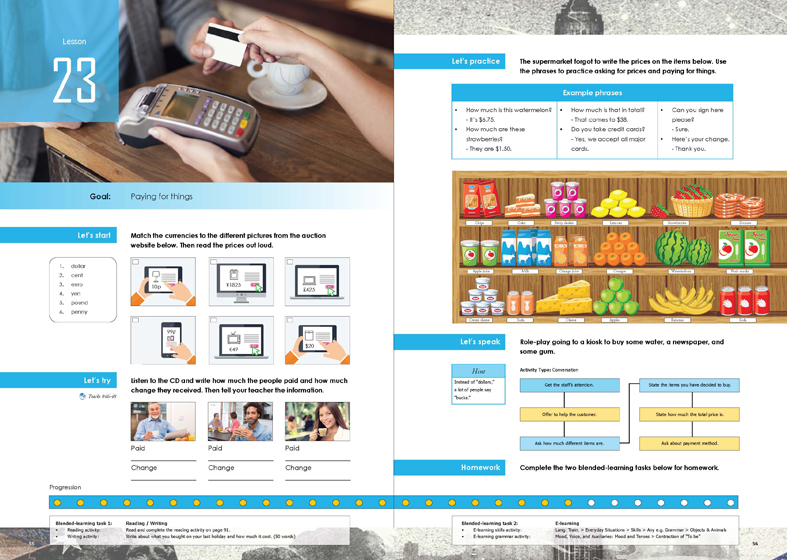
Manuals > General English > Rosetta Stone Advantage > Beginner - Book 1 > Lesson 23
< Previous Lesson | Next Lesson >

By the end of the lesson, the student should be able to go shopping and pay for something.
Communication strategies:
The student should be able to able to talk about a purchase using the two steps below:
1) state how much something cost
2) state the currency that was used
e.g. I bought this newspaper. It cost $2.
The student should be able to able to go shopping and pay for something using the two steps below:
1) ask the price of something (singular / plural)
2) ask about payment
e.g.
A) How much is this?
B) It’s $14.40.
A) Is credit OK?
B) Sure.
Words and rules:
The student should be able to name some basic items in a supermarket.
The student should be able to use singular and plural grammar. e.g. How much is this? It's.. / How much are these? / They are...
The student should be able to state some different currencies and what countries use them.
Appropriateness:
Non-verbal behaviour: We can point at things when we want to identify them.
Register: When talking to staff we usually use a polite register.
Social rules: We usually use the smallest note to pay for something. e.g. we wouldn't use a $100 note to buy a stick of gum.
Cultural references: There are different words for money in each country e.g. In the US people can say "bucks" instead of dollars. In Australia people usually use their cash card to pay for things at the supermarket. This system is called EFTPOS.
Track #46
This newspaper was $1.50. I paid with two dollars, so I got fifty cents change.
Track #47
I bought a sandwich for $5.75. I paid with a ten dollar bill, so I got four dollars and twenty five cents change.
Track #48
This coffee was $3.15. I paid with a five dollar bill, so I got one
dollar and eighty five cents change.
Because the lesson touches on the topic of things in supermarkets, you are welcome to introduce some of the following vocabulary if you like.
1) vegetables (n)
2) chips (n)
3) eggs (n)
4) mushroom (n)
5) margarine (n)
6) beans (n)
7) cereal (n)
8) diapers (n)
9) detergent (n)
10) deodorant (n)
Option 1:
Difficulty ★
Type: Discussion
Purpose: To match countries with currencies
Method: Name some different countries then see if you can name the currency they use.
You could also turn this into a game.
Option 2:
Difficulty ★★
Type: Discussion
Purpose: To discuss different payment methods
Method: Discuss how you usually pay for different things and why.
e.g. I usually pay for drinks with my Suica because it’s so convenient.
Option 3:
Difficulty ★★★
Type: Role-play
Purpose: Problem solving.
Method: Role-play paying by credit card but there is a problem and the card doesn’t work.
Extra questions you might like to ask in the lesson
- How much is that it total?
- Cash or charge?
- Please enter your PIN number.
Let’s start
Match the currencies to the different pictures from the auction website below. Then read the prices out loud.
Top line (L>R)
Penny / yen / pound
Bottom line (L>R)
Cent / euro / dollar
Let’s try
Listen to the CD and write how much the people paid and how much change they received. Then tell your teacher the information.
Track #46
This newspaper was $1.50. He paid with two dollars, so he got fifty cents change.
Track #47
He bought a sandwich for $5.75. He paid with a ten dollar bill, so I got four dollars and twenty five cents change.
Track #48
This coffee was $3.15. She paid with a five dollar bill, so she got one dollar and eighty five cents change.
Let’s practice
The supermarket forgot to write the prices on the items below. Use the phrases to practice asking for prices and paying for things.
A) How much is this watermelon?
B) It’s $6.75.
A) How much are these strawberries?
B) They are $1.50.
A) How much is that in total?
B) That comes to $8.25.
A) Do you take credit cards?
B) Yes, we accept all major cards.
A) OK. Visa, please
B) Can you sign here please?
A) Sure.
Let’s speak
Role-play going to a kiosk to buy some water, a newspaper, and some gum.
A) Excuse me.
B) Can I help you?
A) How much is the water?
B) $1
A) And how much is this newspaper?
B) $2
A) How about this one?
B) $3
A) And how much is this gum?
B) 50 cents.
A) OK. I’ll take these three.
B) That comes to $4.50. How would you like to pay?
A) Cash.